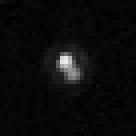Top Qs
Timeline
Chat
Perspective
65489 Ceto
Minor planet From Wikipedia, the free encyclopedia
Remove ads
65489 Ceto, as a binary also (65489) Ceto–Phorcys[4] (provisional designation 2003 FX128), is a binary trans-Neptunian object (TNO) discovered on March 22, 2003, by Chad A. Trujillo and Michael Brown at Palomar. It is named after the sea goddess Ceto from Greek mythology. It came to perihelion in 1989.[2]
Remove ads
Physical characteristics
Summarize
Perspective

Ceto is an example of a close binary TNO system in which the components are of similar size. Combined observations with the infrared Spitzer Space Telescope and the Hubble Space Telescope allow the diameter of Ceto itself to be estimated at 174+16
−18 km and the diameter of Phorcys at 132+6
−14 km, assuming equal albedo for both components.[4]
The binary nature of Ceto enables direct calculation of the system mass, allowing estimation of the masses of the components and providing additional constraints on their composition. The estimated density of Ceto is 1.37+0.66
−0.32 g/cm3, significantly less than that of the large TNOs (Haumea: 3.0 g/cm3, Eris: 2.26, Pluto: 2.03, Charon: 1.65) but significantly more than that of smaller TNOs (e.g. 0.7 g/cm3 for (26308) 1998 SM165). Phorcys has a mass of about 1.67×1018 kg.[4] Unless the bodies are porous, the density is consistent with rock–ice composition, with rock content around 50%.[4]
It has been suggested that tidal forces, together with other potential heat sources (e.g. collisions or 26Al decay) might have raised the temperature sufficiently to crystallise amorphous ice and reduce the void space inside the object. The same tidal forces could be responsible for the quasi-circular orbits of the components of Ceto.[4]
Remove ads
Satellite
Ceto's satellite was identified as a binary on April 11, 2006, by K. Noll, H. Levison, W. Grundy and D. Stephens using the Hubble Space Telescope; the object was named Phorcys after the Greek sea god, formally (65489) Ceto I. Using an extended definition of a centaur as an object on a non-resonant (unstable) orbit with its perihelion inside the orbit of Neptune,[9] the Ceto system can be considered the second known binary centaur.[4]
Phorcys's diameter has been estimated to be 171±10[3] and 132+6
−14 km.[4]
Remove ads
See also
References
External links
Wikiwand - on
Seamless Wikipedia browsing. On steroids.
Remove ads

